Reduced Methane Emissions from Santa Barbara Marine Seeps
Abstract
1. Introduction
2. Materials and Methods
2.1. Instrumentation
2.2. Inversion of In Situ Data
2.3. Retrieval of MAMAP Remote Sensing Data
2.4. Gaussian Forward Model
3. Results
3.1. Airborne Measurements from 4 June 2014
3.2. Airborne Measurements from 25 August 2014
3.3. Ground Based In Situ Measurements
4. Discussion
5. Conclusions
Acknowledgments
Author Contributions
Conflicts of Interest
Appendix A. In Situ Wind Profiles

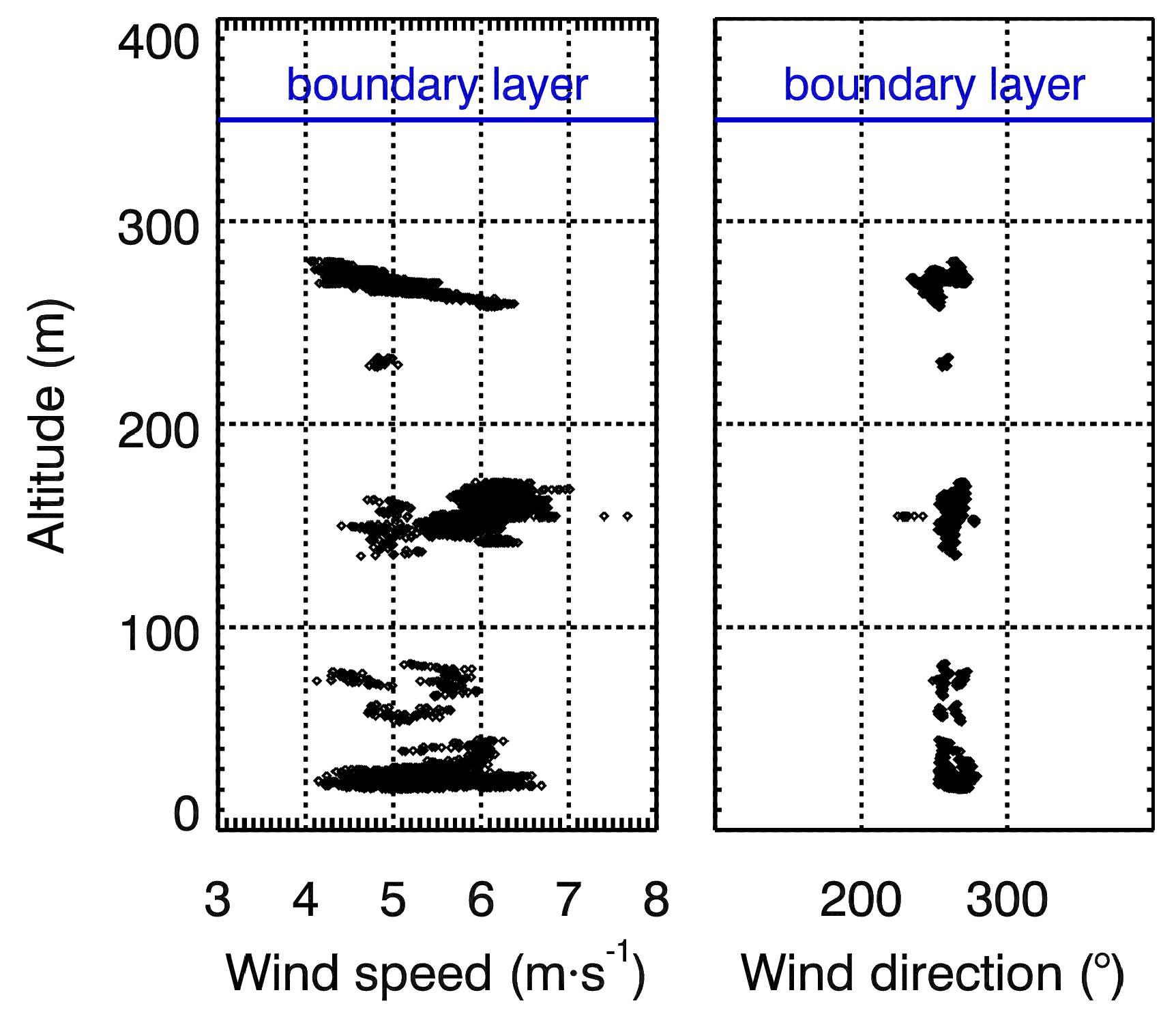
References
- Ciais, P.; Sabine, C.; Bala, G.; Bopp, L.; Brovkin, V.; Canadell, J.; Chhabra, A.; DeFries, R.; Galloway, J.; Heimann, M.; et al. Climate Change 2013: The Physical Science Basis. Contribution of Working Group I to the Fifth Assessment Report of the Intergovernmental Panel on Climate Change; Stocker, T.F., Qin, D., Plattner, G.-K., Tignor, M., Allen, S.K., Boschung, J., Nauels, A., Xia, Y., Bex, V., Midgley, P.M., Eds.; Cambridge University Press: Cambridge, UK; New York, NY, USA, 2013. [Google Scholar]
- Saunois, M.; Bousquet, P.; Poulter, B.; Peregon, A.; Ciais, P.; Canadell, J.G.; Dlugokencky, E.J.; Etiope, G.; Bastviken, D.; Houweling, S.; et al. The global methane budget 2000–2012. Earth Syst. Sci. Data 2016, 8, 697–751. [Google Scholar] [CrossRef]
- Allen, A.A.; Schlueter, R.S.; Mikolaj, P.G. Natural Oil Seepage at Coal Oil Point, Santa Barbara, California. Science 1970, 170, 974–977. [Google Scholar] [CrossRef] [PubMed]
- Hornafius, J.S.; Quigley, D.; Luyendyk, B.P. The world’s most spectacular marine hydrocarbon seeps (Coal Oil Point, Santa Barbara Channel, California): Quantification of emissions. J. Geophys. Res. Oceans 1999, 104, 20703–20711. [Google Scholar] [CrossRef]
- Leifer, I.; Luyendyk, B.P.; Boles, J.; Clark, J.F. Natural marine seepage blowout: Contribution to atmospheric methane. Glob. Biogechem. Cycles 2006, 20. [Google Scholar] [CrossRef]
- Leifer, I.; Kamerling, M.J.; Luyendyk, B.P.; Wilson, D.S. Geologic control of natural marine hydrocarbon seep emissions, Coal Oil Point seep field, California. Geo-Mar. Lett. 2010, 30, 331–338. [Google Scholar] [CrossRef]
- Leifer, I.; Roberts, D.; Margolis, J.; Kinnaman, F. In situ sensing of methane emissions from natural marine hydrocarbon seeps: A potential remote sensing technology. Earth Planet. Sci. Lett. 2006, 245, 509–522. [Google Scholar] [CrossRef]
- Clark, J.F.; Washburn, L.; Schwager Emery, K. Variability of gas composition and flux intensity in natural marine hydrocarbon seeps. Geo-Mar. Lett. 2009, 30, 379–388. [Google Scholar] [CrossRef]
- Bradley, E.; Leifer, I.; Roberts, D. Long-term monitoring of a marine geologic hydrocarbon source by a coastal air pollution station in Southern California. Atmos. Environ. 2010, 44, 4973–4981. [Google Scholar] [CrossRef]
- Leifer, I.; Boles, J. Measurement of marine hydrocarbon seep flow through fractured rock and unconsolidated sediment. Mar. Pet. Geol. 2005, 22, 551–568. [Google Scholar] [CrossRef]
- Leifer, I.; Culling, D. Formation of seep bubble plumes in the Coal Oil Point seep field. Geo-Mar. Lett. 2010, 30, 339–353. [Google Scholar] [CrossRef]
- Roberts, D.A.; Bradley, E.S.; Cheung, R.; Leifer, I.; Dennison, P.E.; Margolis, J.S. Mapping methane emissions from a marine geological seep source using imaging spectrometry. Remote Sens. Environ. 2010, 114, 592–606. [Google Scholar] [CrossRef]
- Bradley, E.S.; Leifer, I.; Roberts, D.A.; Dennison, P.E.; Washburn, L. Detection of marine methane emissions with AVIRIS band ratios. Geophys. Res. Lett. 2011, 38. [Google Scholar] [CrossRef]
- Thorpe, A.K.; Frankenberg, C.; Roberts, D.A. Retrieval techniques for airborne imaging of methane concentrations using high spatial and moderate spectral resolution: Application to AVIRIS. Atmos. Meas. Tech. 2014, 7, 491–506. [Google Scholar] [CrossRef]
- Leifer, I.; Wilson, K. The tidal influence on oil and gas emissions from an abandoned oil well: Nearshore Summerland, California. Mar. Pollut. Bull. 2007, 54, 1495–1506. [Google Scholar] [CrossRef] [PubMed]
- Boles, J.R.; Clark, J.F.; Leifer, I.; Washburn, L. Temporal variation in natural methane seep rate due to tides, Coal Oil Point area, California. J. Geophys. Res. Oceans 2001, 106, 27077–27086. [Google Scholar] [CrossRef]
- Fischer, P.J. Oil and tar seeps, Santa Barbara basin, California. In California Offshore Gas, Oil, and Tar Seeps; Fischer, P.J., Ed.; California State Lands Commission: Sacramento, CA, USA, 1978; pp. 1–62. [Google Scholar]
- Lee, C.M.; Cable, M.L.; Hook, S.J.; Green, R.O.; Ustin, S.L.; Mandl, D.J.; Middleton, E.M. An introduction to the {NASA} Hyperspectral InfraRed Imager (HyspIRI) mission and preparatory activities. Remote Sens. Environ. 2015, 167, 6–19. [Google Scholar]
- Bovensmann, H.; Buchwitz, M.; Burrows, J.P.; Reuter, M.; Krings, T.; Gerilowski, K.; Schneising, O.; Heymann, J.; Tretner, A.; Erzinger, J. A remote sensing technique for global monitoring of power plant CO2 emissions from space and related applications. Atmos. Meas. Tech. 2010, 3, 781–811. [Google Scholar] [CrossRef]
- Buchwitz, M.; Reuter, M.; Bovensmann, H.; Pillai, D.; Heymann, J.; Schneising, O.; Rozanov, V.; Krings, T.; Burrows, J.P.; Boesch, H.; et al. Carbon Monitoring Satellite (CarbonSat): Assessment of atmospheric CO2 and CH4 retrieval errors by error parameterization. Atmos. Meas. Tech. 2013, 6, 3477–3500. [Google Scholar] [CrossRef]
- Thompson, D.R.; Leifer, I.; Bovensmann, H.; Eastwood, M.; Fladeland, M.; Frankenberg, C.; Gerilowski, K.; Green, R.O.; Kratwurst, S.; Krings, T.; et al. Real-time remote detection and measurement for airborne imaging spectroscopy: A case study with methane. Atmos. Meas. Tech. 2015, 8, 4383–4397. [Google Scholar] [CrossRef]
- Gerilowski, K.; Krautwurst, S.; Koyler, R.; Jonsson, H.; Krings, T.; Horstjann, M.; Leifer, I.; Schuettemeyer, D.; Fladeland, M.; Burrows, J.P.; et al. Remote Sensing of Large Scale Methane Emission Sources with the Methane Airborne MAPper (MAMAP) Instrument over the Kern River and Kern Front Oil Fields and Validation through Airborne In-Situ Measurements—Initial Results from COMEX; American Geophysical Union: Washington, DC, USA, 2014. [Google Scholar]
- Krautwurst, S.; Gerilowski, K.; Jonsson, H.H.; Thompson, D.R.; Kolyer, R.W.; Iraci, L.T.; Thorpe, A.K.; Horstjann, M.; Eastwood, M.; Leifer, I.; et al. Methane emissions from a Californian landfill, determined from airborne remote sensing and in situ measurements. Atmos. Meas. Tech. 2017, 10, 3429–3452. [Google Scholar] [CrossRef]
- Gerilowski, K.; Tretner, A.; Krings, T.; Buchwitz, M.; Bertagnolio, P.P.; Belemezov, F.; Erzinger, J.; Burrows, J.P.; Bovensmann, H. MAMAP—A new spectrometer system for column-averaged methane and carbon dioxide observations from aircraft: Instrument description and performance analysis. Atmos. Meas. Tech. 2011, 4, 215–243. [Google Scholar] [CrossRef]
- Gerilowski, K.; Krings, T.; Hartmann, J.; Buchwitz, M.; Sachs, T.; Erzinger, J.; Burrows, J.P.; Bovensmann, H. Atmospheric remote sensing constraints on direct sea-air methane flux from the 22/4b North Sea massive blowout bubble plume. Mar. Pet. Geol. 2015, 68 Part B, 824–835. [Google Scholar] [CrossRef][Green Version]
- Krings, T.; Gerilowski, K.; Buchwitz, M.; Hartmann, J.; Sachs, T.; Erzinger, J.; Burrows, J.P.; Bovensmann, H. Quantification of methane emission rates from coal mine ventilation shafts using airborne remote sensing data. Atmos. Meas. Tech. 2013, 6, 151–166. [Google Scholar] [CrossRef]
- Krings, T.; Gerilowski, K.; Buchwitz, M.; Reuter, M.; Tretner, A.; Erzinger, J.; Heinze, D.; Pflüger, U.; Burrows, J.P.; Bovensmann, H. MAMAP—A new spectrometer system for column-averaged methane and carbon dioxide observations from aircraft: Retrieval algorithm and first inversions for point source emission rates. Atmos. Meas. Tech. 2011, 4, 1735–1758. [Google Scholar] [CrossRef]
- Krings, T.; Neininger, B.; Gerilowski, K.; Krautwurst, S.; Buchwitz, M.; Burrows, J.P.; Lindemann, C.; Ruhtz, T.; Schüttemeyer, D.; Bovensmann, H. Airborne remote sensing and in-situ measurements of atmospheric CO2 to quantify point source emissions. Atmos. Meas. Tech. Discuss. 2016, 2016, 1–30. [Google Scholar] [CrossRef]
- Rella, C.W.; Chen, H.; Andrews, A.E.; Filges, A.; Gerbig, C.; Hatakka, J.; Karion, A.; Miles, N.L.; Richardson, S.J.; Steinbacher, M.; et al. High accuracy measurements of dry mole fractions of carbon dioxide and methane in humid air. Atmos. Meas. Tech. 2013, 6, 837–860. [Google Scholar]
- Frankenberg, C.; Meirink, J.F.; van Weele, M.; Platt, U.; Wagner, T. Assessing Methane Emissions from Global Space-Borne Observations. Science 2005, 308, 1010–1014. [Google Scholar] [CrossRef] [PubMed]
- Schepers, D.; Guerlet, S.; Butz, A. Methane retrievals from Greenhouse Gases Observing Satellite (GOSAT) shortwave infrared measurements: Performance comparison of proxy and physics retrieval algorithms. J. Geophys. Res. 2012, 117. [Google Scholar] [CrossRef]
- Rozanov, V.; Rozanov, A.; Kokhanovsky, A.; Burrows, J. Radiative transfer through terrestrial atmosphere and ocean: Software package {SCIATRAN}. J. Quant. Spectrosc. Radiat. Transf. 2014, 133, 13–71. [Google Scholar] [CrossRef]
- Cox, C.; Munk, W. Measurement of the Roughness of the Sea Surface from Photographs of the Sun’s Glitter. J. Opt. Soc. Am. 1954, 44, 838–850. [Google Scholar] [CrossRef]
- Hasse, L.; Weber, H. On the conversion of Pasquill categories for use over sea. Bound. Layer Meteorol. 1985, 31, 177–185. [Google Scholar] [CrossRef]
- Jeong, S.; Newman, S.; Zhang, J.; Andrews, A.E.; Bianco, L.; Bagley, J.; Cui, X.; Graven, H.; Kim, J.; Salameh, P.; et al. Estimating methane emissions in California’s urban and rural regions using multitower observations. J. Geophys. Res. Atmos. 2016, 121, 13031–13049. [Google Scholar] [CrossRef]
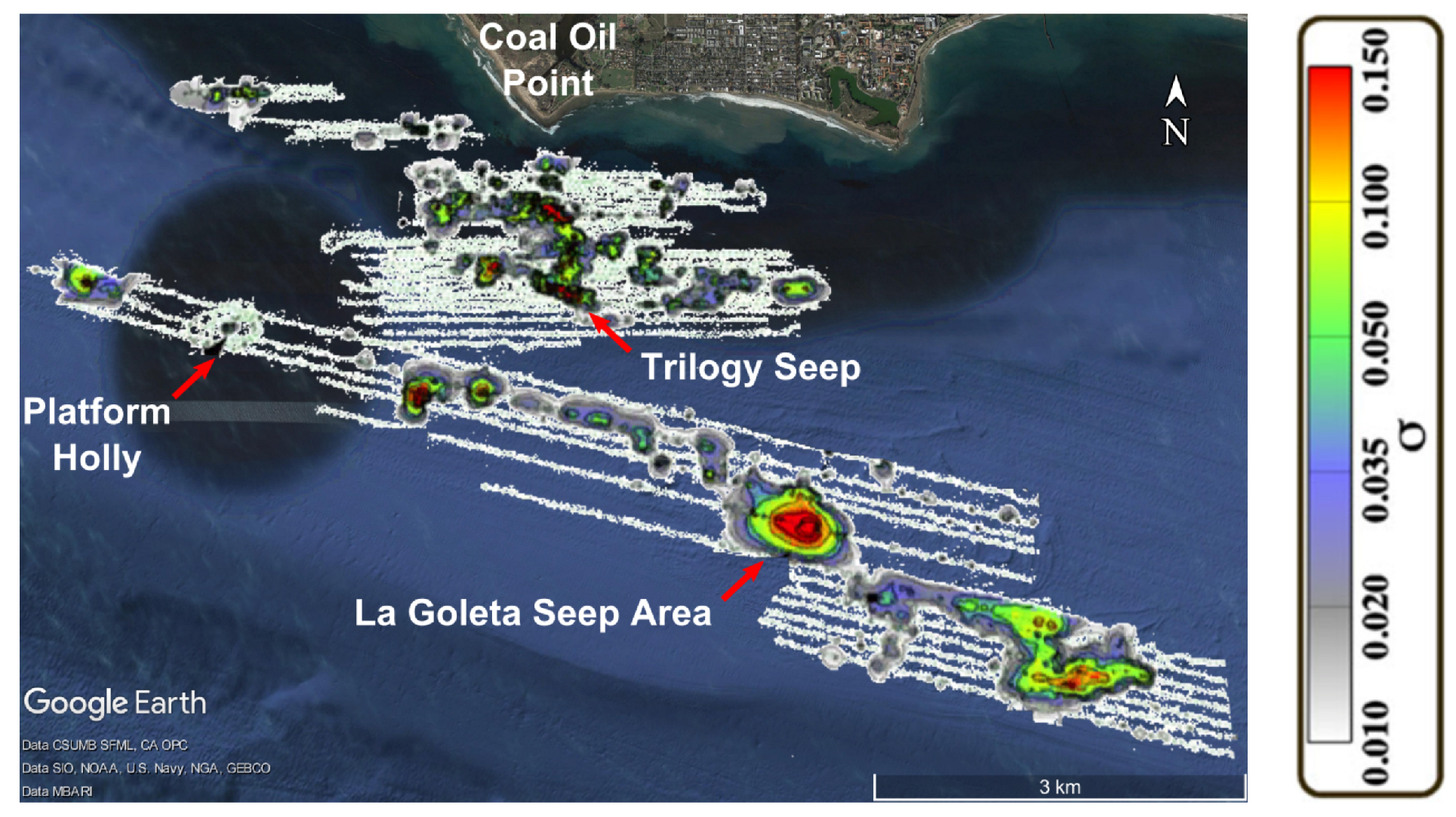
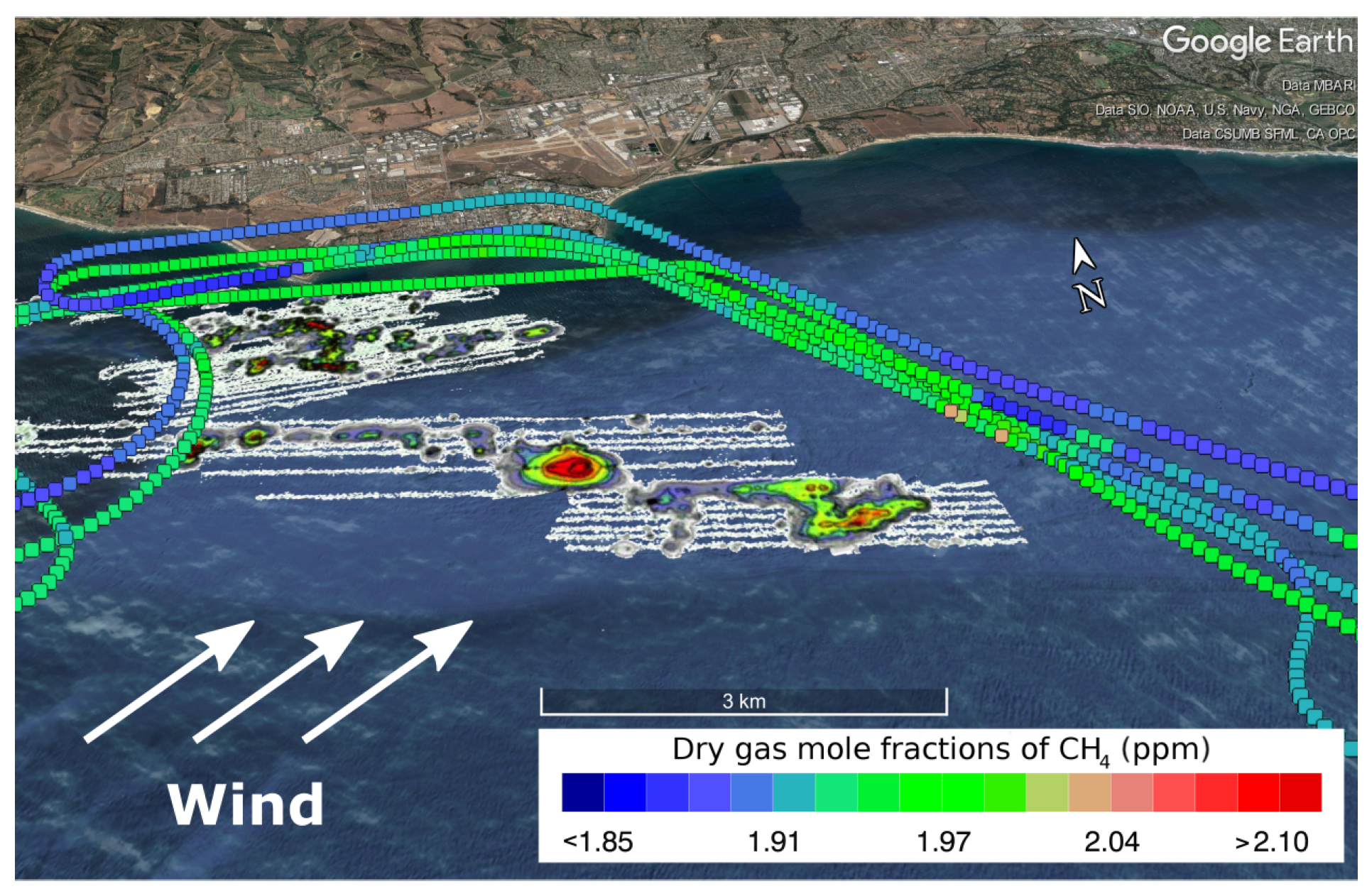
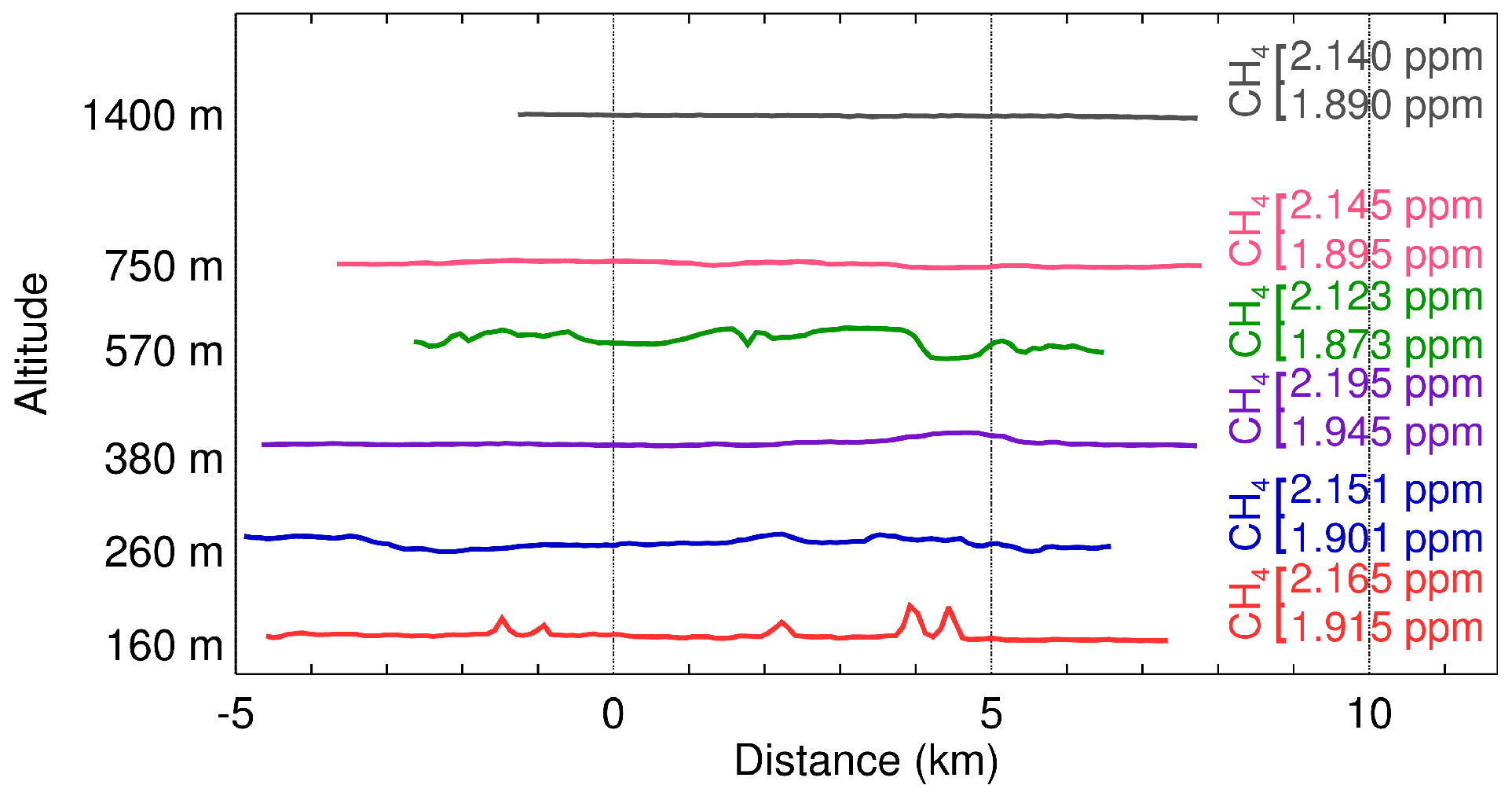


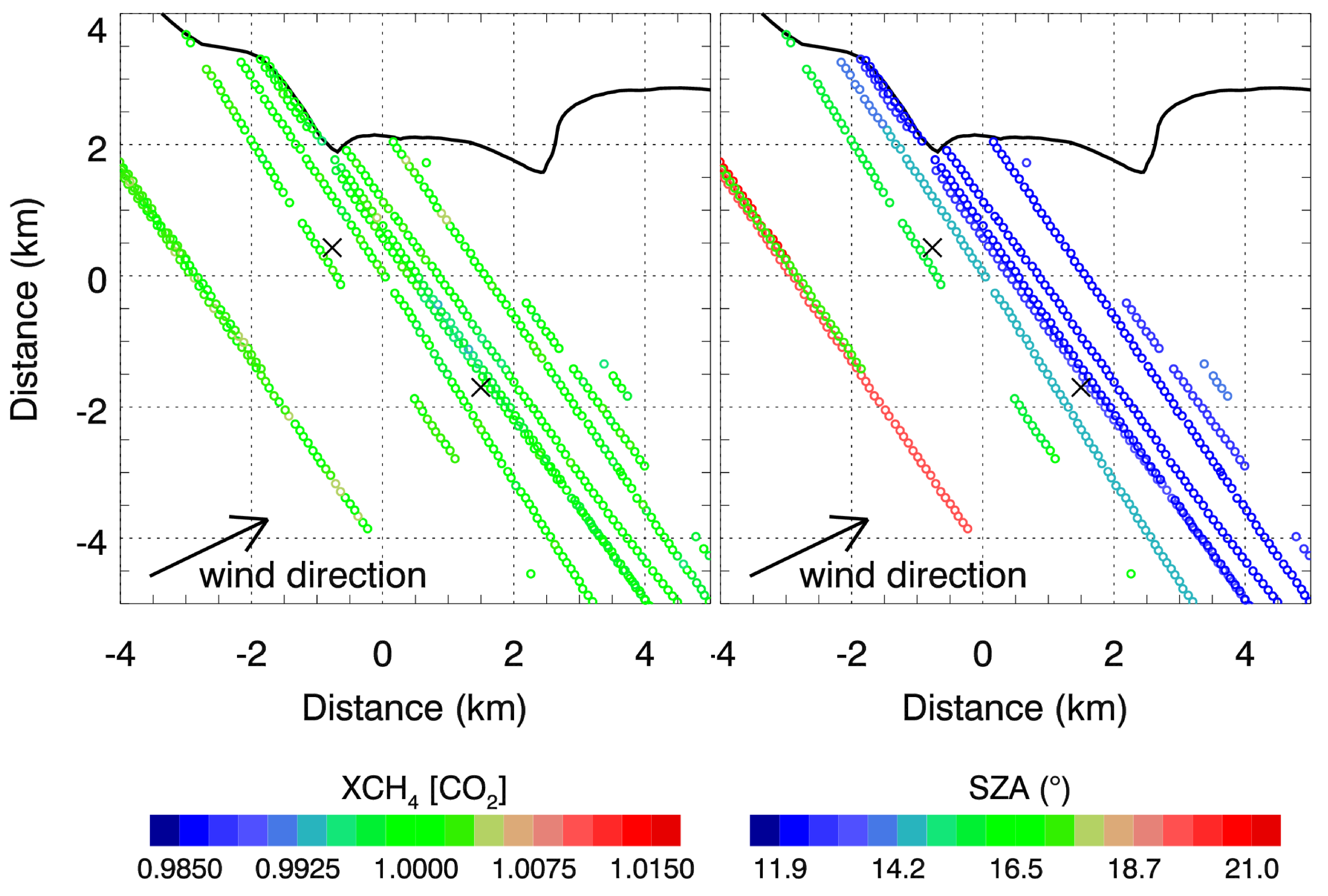
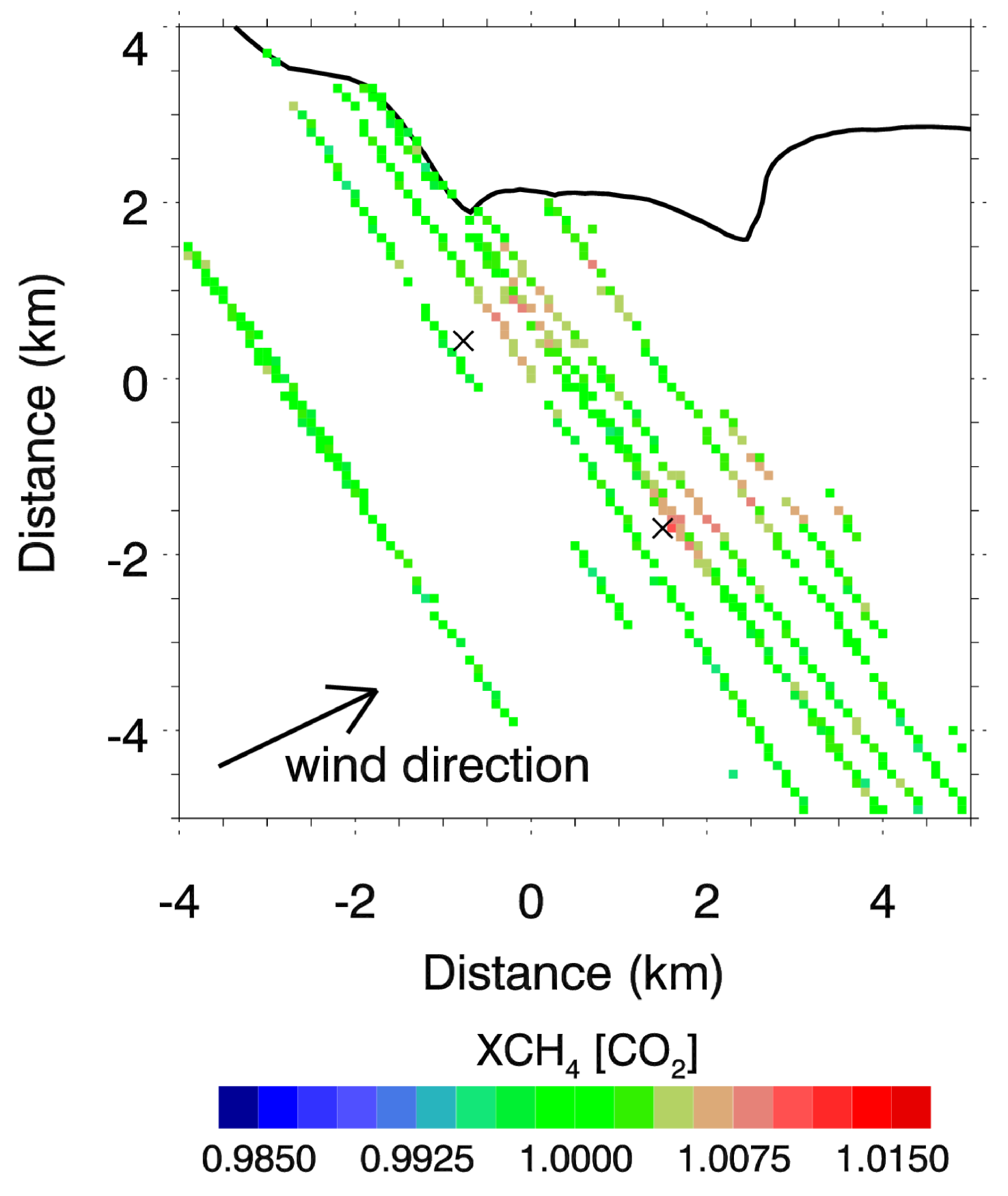
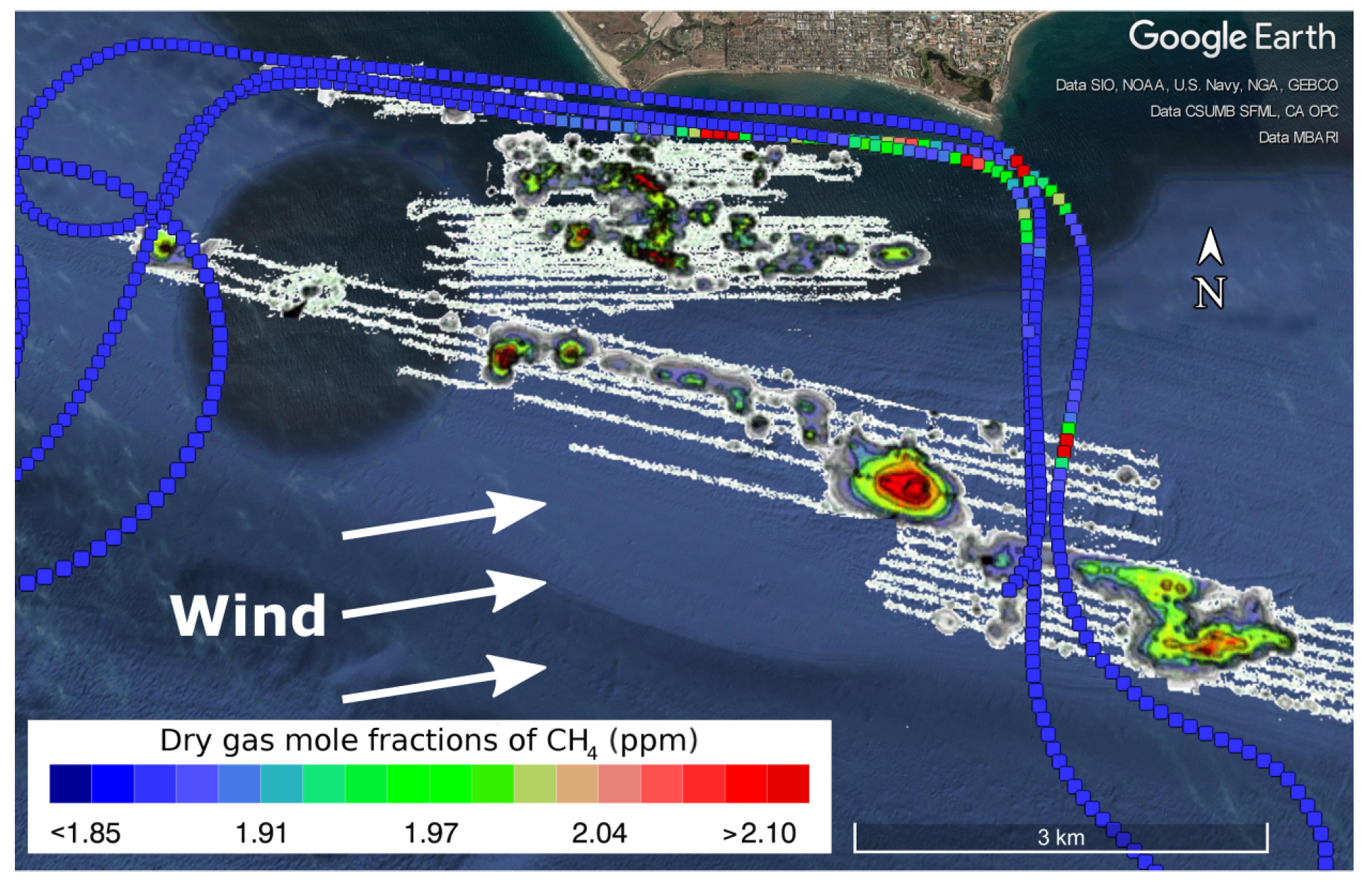
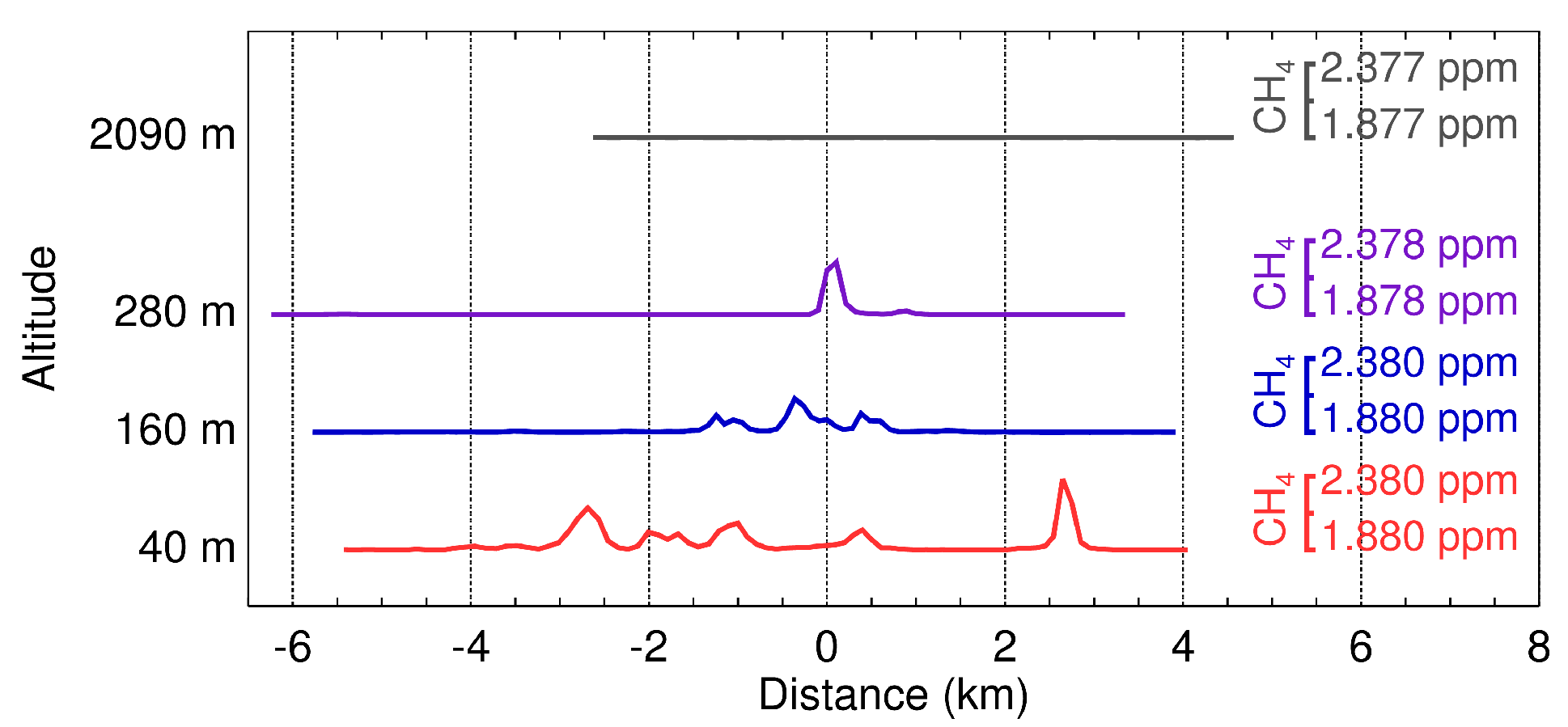
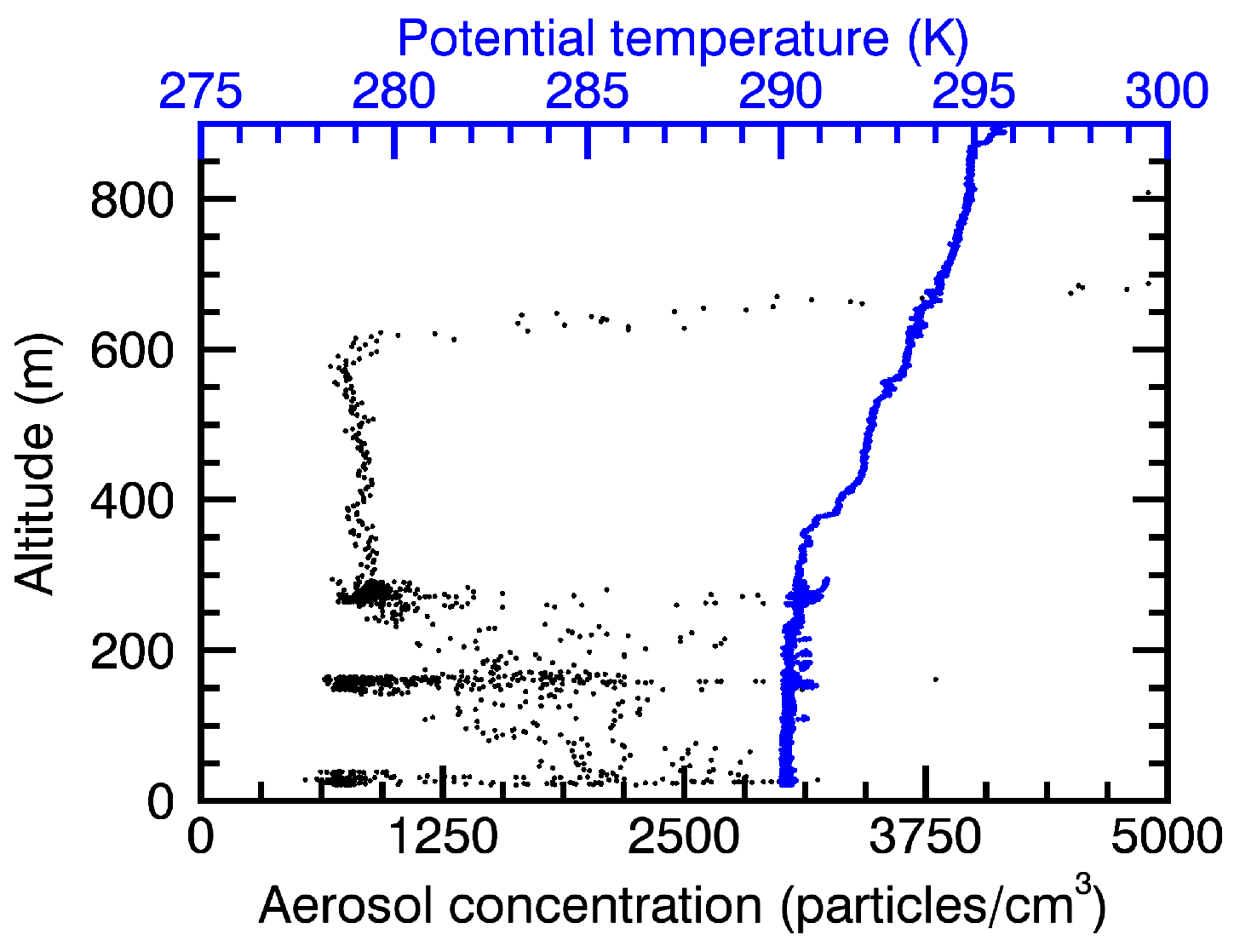

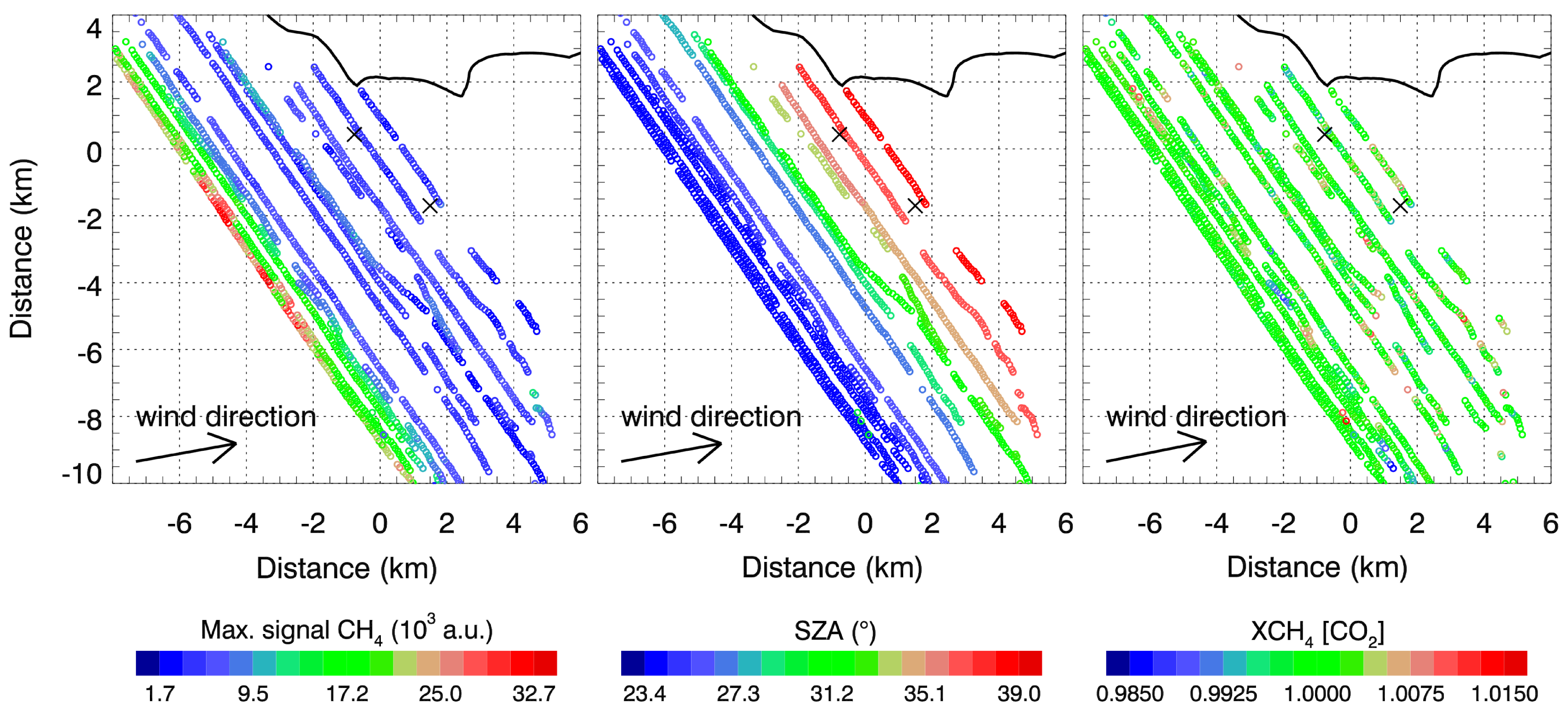
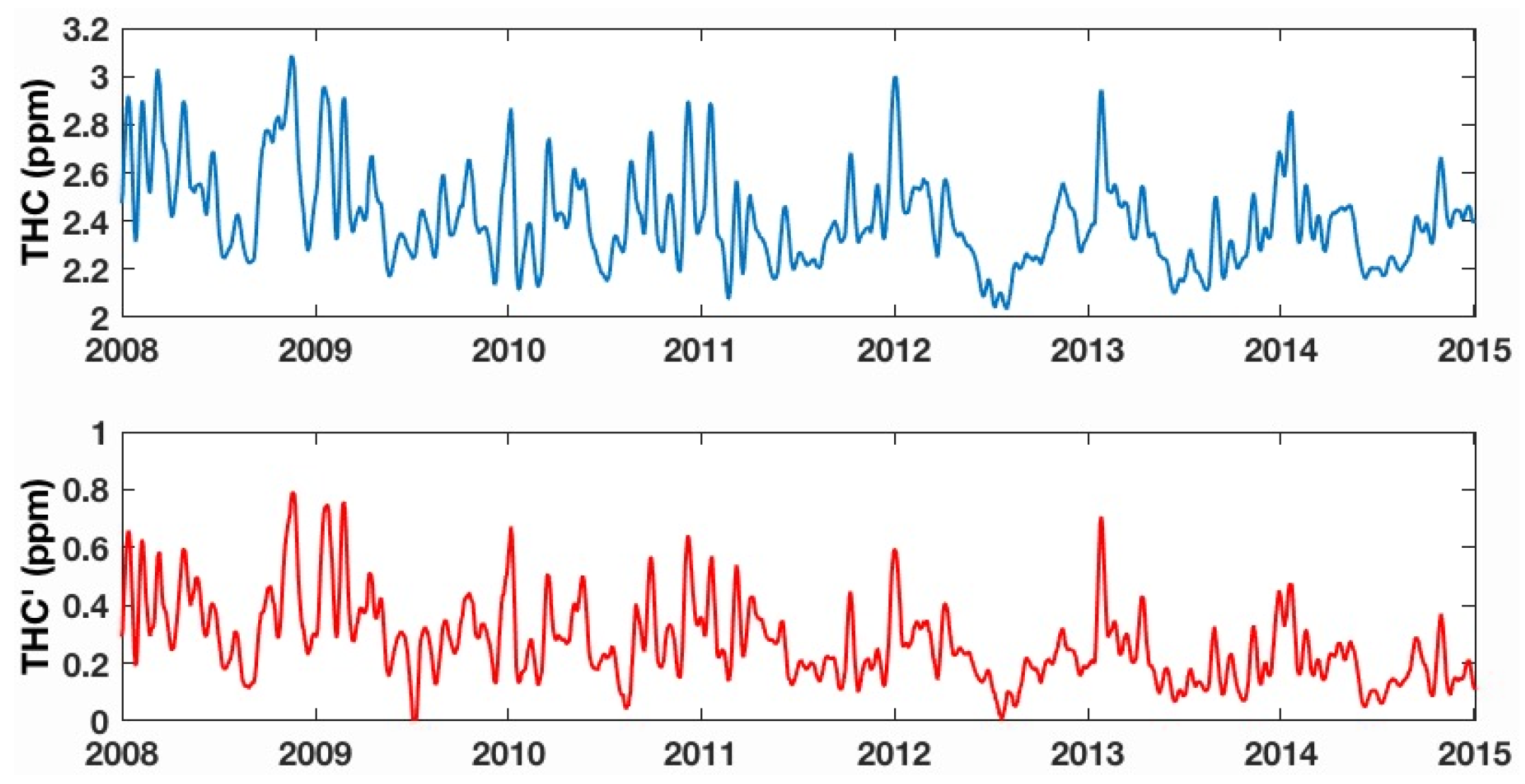
| Flight Date | 4 June 2014 | 25 August 2014 |
|---|---|---|
| Emission rate estimate (kt CH y) | 1.6 | 5.1 |
| Error source | Uncertainty | |
| Wind speed | 14.2% | 9.4% |
| CH background concentration/area | 6.5% | 0.4% |
| Unknown surface CH concentration | 19.3% | 7.6% |
| Boundary layer height | 28.8% | 8.1% |
| Unknown boundary layer CH concentration e | 7.2% | 4.2% |
| Time lag | 7.6% | 4.2% |
| Kriging approach | 12.8% | 11.2% |
| Total uncertainty | 41.5% | 19.3% |
© 2017 by the authors. Licensee MDPI, Basel, Switzerland. This article is an open access article distributed under the terms and conditions of the Creative Commons Attribution (CC BY) license (http://creativecommons.org/licenses/by/4.0/).
Share and Cite
Krings, T.; Leifer, I.; Krautwurst, S.; Gerilowski, K.; Horstjann, M.; Bovensmann, H.; Buchwitz, M.; Burrows, J.P.; Kolyer, R.W.; Jonsson, H.H.; et al. Reduced Methane Emissions from Santa Barbara Marine Seeps. Remote Sens. 2017, 9, 1162. https://doi.org/10.3390/rs9111162
Krings T, Leifer I, Krautwurst S, Gerilowski K, Horstjann M, Bovensmann H, Buchwitz M, Burrows JP, Kolyer RW, Jonsson HH, et al. Reduced Methane Emissions from Santa Barbara Marine Seeps. Remote Sensing. 2017; 9(11):1162. https://doi.org/10.3390/rs9111162
Chicago/Turabian StyleKrings, Thomas, Ira Leifer, Sven Krautwurst, Konstantin Gerilowski, Markus Horstjann, Heinrich Bovensmann, Michael Buchwitz, John P. Burrows, Richard W. Kolyer, Haflidi H. Jonsson, and et al. 2017. "Reduced Methane Emissions from Santa Barbara Marine Seeps" Remote Sensing 9, no. 11: 1162. https://doi.org/10.3390/rs9111162
APA StyleKrings, T., Leifer, I., Krautwurst, S., Gerilowski, K., Horstjann, M., Bovensmann, H., Buchwitz, M., Burrows, J. P., Kolyer, R. W., Jonsson, H. H., & Fladeland, M. M. (2017). Reduced Methane Emissions from Santa Barbara Marine Seeps. Remote Sensing, 9(11), 1162. https://doi.org/10.3390/rs9111162






